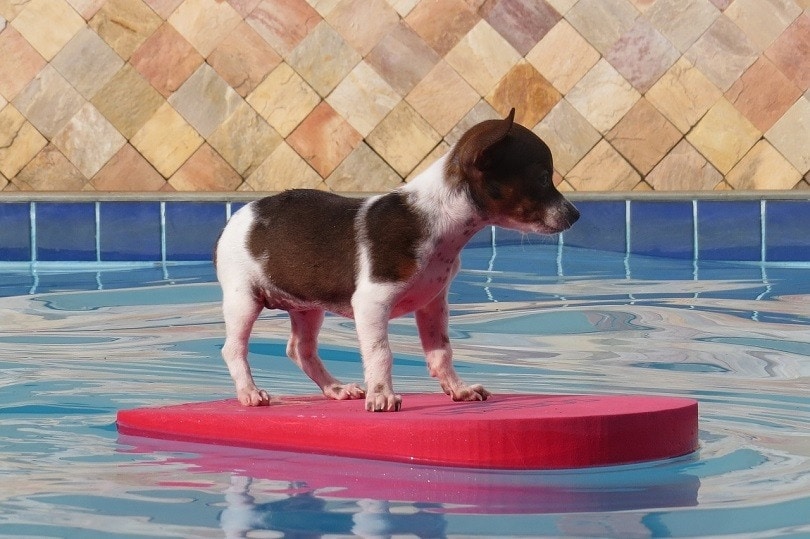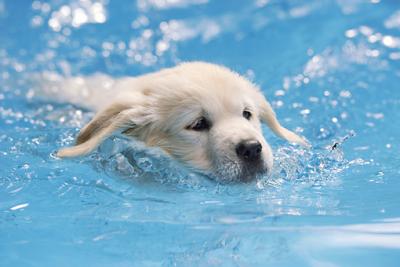LifeWithMyDogs is supported by our audience. When you purchase through one of our links, we may earn a small affiliate commission. As an Amazon Associate I earn from qualifying purchases. Your cost is not affected.
**********
Welcome to the exciting world of puppies and swimming! With their energetic play and boundless curiosity, puppies bring much fun into our lives. But the question we’re exploring today is: “Can puppies swim?” The answer is not as straightforward as it may seem. It’s not just taking a young puppy to a swimming pool and expecting it to start swimming. Factors like dog breeds, the age of the puppy, and water safety precautions all come into play. Not all puppies, or even adult dogs, are natural swimmers.
The dog paddle is a term we often hear, but not all dogs can swim immediately. Many dogs, especially brachycephalic breeds with short snouts, can have trouble breathing and staying afloat in deeper water. On the other hand, breeds like the Labrador Retriever and the Portuguese Water Dog, bred to retrieve water birds, are natural swimmers and usually enjoy splashing in the water. Regardless of breed, however, most dogs benefit from having swimming lessons in a controlled environment, such as a kiddie pool or baby pool, where the water temperature can monitor closely.
A critical aspect to consider when introducing a puppy to swimming is safety. A life vest or a life jacket for dogs is a must-have for any swimming session. This is particularly true when the puppy is just getting its feet wet or dealing with cold water or chlorine pools. Keeping swimming sessions short and using positive reinforcement can help make the experience a fun activity for your puppy. Never leave a dog unsupervised in a swimming pool, or water is crucial. These water safety tips and careful attention to your dog’s body language and any signs of distress can help keep your puppy safe while it learns to swim.
Puppies, similar to human infants, undergo significant physical and behavioral changes as they grow. These transformations shape their development and prepare them for adulthood.
Developmental Stages of Puppies
Puppies pass through several stages before they mature into adult dogs. Each phase brings unique developmental milestones from neonatal to transition, socialization, and adolescence. During the neonatal stage (0-2 weeks), puppies are blind and deaf, but their sense of touch and taste is present. They primarily feed and sleep.
The transitional stage (2-4 weeks) sees their eyes and ears open, enabling them to begin interacting with their environment. In the socialization stage (4-12 weeks), puppies begin learning and exhibiting behaviors influenced by their siblings and mother. Their permanent teeth emerge and begin to be weaned off their mother’s milk. Adolescence (6-18 months) brings sexual maturity and more independent behaviors.
Physical Characteristics and Adaptations
As puppies mature, they exhibit breed-specific physical characteristics and adaptations. Their bodies grow, their teeth fully develop, and their fur thickens. Puppies of Labrador Retriever and Golden Retriever breeds, known for their swimming abilities, start to show webbed feet—an adaptation that enhances their swimming efficiency.
Natural Instincts and Behaviors Related to Water
While most puppies show an instinctive dog paddle when first introduced to water, not all dogs are natural swimmers. Certain breeds, like the Portuguese Water Dog and the Labrador Retriever, historically bred to retrieve water birds, display a more pronounced aptitude for swimming.
Yet, it’s important to understand that puppies are not born with a full-fledged ability to swim. They need a gradual introduction to shallow water, with swimming sessions kept short initially. As the puppy grows and becomes more confident, it can expose to deeper water. However, the depth should always monitor, and swimming in colder water should avoid due to puppies’ sensitivity to temperature. Safety precautions, such as using life vests and maintaining supervision, are necessary, especially with breeds that aren’t natural swimmers.
Factors Influencing a Puppy’s Ability to Swim
Swimming is a fun activity for dogs. It provides a refreshing way to exercise while offering the opportunity to cool off during hot weather. Many dogs love swimming, but not all puppies instinctively know how to swim. If you have a new puppy, you may wonder when to let your dog start swimming. Here are some key factors to consider:
Breed Considerations
Breed plays a critical role in a dog’s ability to swim. Some dogs are natural swimmers due to their breed characteristics. For instance, breeds like the Labrador Retriever are adept in the water, with their natural body shape and webbed feet. On the other hand, breeds like Bulldogs or Dachshunds have body shapes that make swimming more challenging. These dogs may need a life vest or jacket to swim safely, even in shallow water.
The age at which old puppies should start swimming depends on the breed. Breeds that are natural swimmers may start swimming at around ten weeks, while others might need more time to become comfortable in the water.
Puppy’s Temperament and Confidence
A puppy’s temperament and confidence can significantly influence their swimming abilities. A timid puppy might be afraid of the water, while a more confident young dog may dive in without fear. Regardless of your puppy’s temperament, it is vital to introduce them to water gradually and in a controlled environment. Letting your puppy swim in shallow water under supervision will help them build confidence. A good dog life vest for your pup can also help build their confidence while ensuring their safety.
Exposure to Water and Early Experiences
Exposure to water and a puppy’s early experiences can shape their comfort level with swimming. A puppy introduced to water positively and controlled is likelier to enjoy swimming in the pool or other bodies of water. This introduction should be gradual, starting with shallow water before moving to deeper areas. When starting the first few swim sessions, ensure the water temperature is warm enough to avoid shocking the puppy’s system. Cold pool water can scare a puppy, turning them off swimming.
Physical Health and Condition
A puppy’s physical health and condition impact their swimming ability. Puppies with a strong, well-conditioned physique can swim better than those without good health or condition.
Before swimming, ensure your puppy is in good health. Be aware of potential threats like water toxicity or ear infections resulting from dirty water. Water snakes are also a risk in some areas, so the environment must monitor closely.
Can Puppies Swim?
Many dog owners wonder whether their new puppies can swim. While adult dogs are known for their love of water, can puppies, with their underdeveloped motor skills and natural fears, swim too?
Factors Why Puppies Can Swim
Believe it or not, many puppies are natural swimmers. Though their skills may be crude initially, their natural body instincts kick in when they touch the water, making a swim session a fun activity even for a young dog.

Natural Swimming Ability
From the moment a puppy is born, it can swim intuitively. This instinct, inherited from their wolf ancestors, allows even young dogs to navigate water safely. Of course, just because they have a natural swimming ability doesn’t mean every swim session should be in deep water. Like any good dog training, starting in shallow water and gradually increasing the depth as they get more comfortable is essential.
Paddling and Buoyancy Instincts
Puppies also have a natural paddling instinct that allows them to stay afloat. When placed in water, their front and rear legs paddle instinctively, maintaining their buoyancy. It’s fascinating to watch, and it’s one reason why dog swimming is so much fun for both the owner and the pet.
Young Age Advantage
The old saying “the sooner, the better” applies perfectly here. Old, should puppies start swimming? Ideally, a puppy should start swimming lessons around ten weeks of age. They are usually fearless and curious at this young age, which helps them adjust to new experiences like swimming in the pool.
Factors Why Puppies Cannot Swim
While puppies may have the instincts for swimming, there are a few reasons why some puppies might not take to water as easily as their adult dog counterparts.
Lack of Developed Motor Skills
Puppies may have natural swimming instincts, but they only sometimes have the developed motor skills to swim effectively. Their paddling may keep them afloat, but they often struggle to navigate the water. They must be monitored closely during swim sessions and always wear a life vest or life jacket to stay safe.
Fear or Discomfort with Water
Some puppies may be uncomfortable or scared of water. If a new puppy shows signs of fear or discomfort, it’s essential to take it slow. Start by introducing them to shallow water, like a kiddie pool, before moving to deeper waters.
Health or Physical Limitations
Certain breeds of dogs or puppies with specific health or physical conditions may struggle to swim. These may include dogs with short legs, brachycephalic dogs (those with short noses), or puppies with ear infections. Always consult a vet before letting your dog take the plunge.
Safety Precautions for Puppy Swimming
Puppy swimming can be so much fun for you and your new puppy. However, safety precautions are necessary to ensure the young dog’s well-being. As natural swimmers, dogs love to swim. Yet, not all puppies naturally embrace water, and even natural swimmers should monitor closely. It’s essential to understand how old puppies should be to start swimming, the role of life jackets, and water quality considerations to keep the puppy safe during the swim session.
Supervision and Controlled Environments
Adult dogs may seem like natural swimmers when it comes to dog swimming, but puppies are only sometimes as confident. Therefore, supervision is vital, especially in shallow water where a puppy may feel more comfortable. For the first few sessions, please keep your dog in water deep enough for its feet to touch the ground. This gives the puppy a sense of security while gradually introducing swimming. Your presence will make your puppy feel safe, and it can be a fun activity for both of you.
Introduction to Water Gradually
Introducing your puppy to swimming should be a gradual process. Start in shallow water and gradually progress to deeper water as the puppy becomes more comfortable. It’s recommended that puppies start swimming around ten weeks old. Begin by simply letting your puppy get their front and rear legs wet. As they gain confidence, you can gradually introduce deeper water. Remember, warm water will make this process easier. Do not force your puppy into the water if they show signs of fear or discomfort.
Use of Life Jackets or Flotation Devices
Despite being natural swimmers, dogs can benefit from a dog life vest or life jacket. A life vest can be a good dog swimming aid, especially for puppies. A dog life vest can support your puppy’s natural body buoyancy and helps to build confidence in the water. Life jackets also serve as a safety device in deep water, where even the best swimmers can tire. Life jackets should be used in all swimming scenarios, whether in the pool, a pond, or the sea.
Water Quality and Hazards to Consider
Water quality and potential hazards are crucial when considering a puppy swim. You need to be aware of water toxicity, which can cause by harmful bacteria or pollutants in the water. Chlorinated pool water can irritate a puppy’s skin and eyes. Natural bodies of water can hide hazards such as sharp objects, deep spots, or water snakes. Even water temperature can be a hazard – it should be warm enough for a comfortable swim. Ensure your dog does not drink too much pool water, as it can lead to an upset stomach. Regularly check your puppy’s ears after each swim session, as damp ears can lead to ear infections.
In this informative video, it will teach your puppies to swim safely and confidently. From introducing them to water gradually to using positive reinforcement techniques, you’ll gain valuable insights on building their comfort and swimming skills.
Video Credit: @LifeWithLabradors
Promoting Responsible and Safe Puppy Swimming for a Splashing Good Time!
Encouraging appropriate water experiences for puppies is essential to their development and overall well-being. While dogs are natural swimmers, starting swimming lessons at an appropriate age and in a safe environment is crucial. Puppies as young as ten weeks old can begin their swim sessions but under close monitoring and adhering to safety precautions.
Swimming can be a fun activity for both puppies and adult dogs alike. It promotes exercise, strengthens muscles, and provides a refreshing way to beat the heat. However, be aware of potential hazards such as water toxicity or encounters with water snakes. By taking responsible measures and using appropriate safety gear, such as life vests, you can make puppy swimming a safe and enjoyable experience. So, let your dog dive in and make a splash! With responsible and safe puppy swimming practices, you can ensure your furry friend becomes a confident and skilled swimmer while having the time of their life in the water.
Frequently Asked Questions
Can dogs swim?
Yes, dogs can swim. They are natural swimmers and generally enjoy being in the water. However, not all dogs are confident swimmers, so it’s important to introduce them to water gradually.
Should I use a life vest for my dog?
It is recommended to use a life vest or life jacket for dogs, especially if they are inexperienced or swimming in deep water. Life vests provide added buoyancy and can ensure the safety of your furry friend.
How old should puppies be before they start swimming?
Puppies can start swimming at around ten weeks of age. However, it’s crucial to introduce them to the water slowly and in shallow areas. Always monitor them closely to ensure their safety.
Are there any safety precautions I should take while my dog swims?
Yes, there are a few safety precautions to consider. Keep an eye on your dog always, especially in open water. Avoid areas with water toxicity or potential hazards, such as water snakes. Additionally, rinse your dog’s coat after swimming to prevent skin irritation.
Is swimming a fun activity for dogs?
Absolutely! Dogs love swimming, and it can be a great way to provide exercise and mental stimulation. Just create a positive and safe environment for your dog to enjoy their swim sessions.
? Dive into the World of Doggy Fun! ?
Do you own a dog? Discover the joy of swimming and ensure your furry friend’s safety with our expert tips and insights. Whether it’s teaching your puppy to swim or exploring the benefits of swimming for adult dogs, we’ve got you covered!
For more valuable information, visit our website at lifewithmydogs.com. Don’t forget to follow us on our social media channels for daily updates and adorable doggy content:
? Facebook: facebook.com/1LWMD
? Instagram: instagram.com/lifewithmydogs2
? Pinterest: pinterest.com/lifewithmydogs2
? Twitter: twitter.com/LifeWithMyDogs9
Join our community of dog lovers and discover the joys of swimming with your canine companion. Make a splash with your dog’s happiness and well-being. Join the fun today! ??








